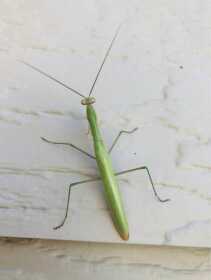A Summer of ... Mantids?

Mantids (or praying/preying mantis) have been spotted everywhere this spring and especially this summer here in Elmore County. These hemimetabolous (egg à nymph à adult) predatory insects are highly beneficial to ecosystems, as they serve as sit-and-wait generalist ambush predators. The native Idaho ground mantid, Litaneutria minor, is less commonly encountered compared to the European mantid, Mantis religiosa, which has certainly taken over as Idaho’s most prolific mantid species.
The European mantid is a relatively large insect (up to 3.5”, mature female) in the order Mantodea, its striking features are the size, 2 pairs of overlapping wings, triangular shaped head, protruding eyes and raptorial front legs for capturing prey items. Interestingly, the European mantid can be distinguished from other species by two “eyespots” that are located on the front legs close to the body (coxa), if threatened they will often extend these legs showing the “eyespots” to help deter other predators, including birds.
